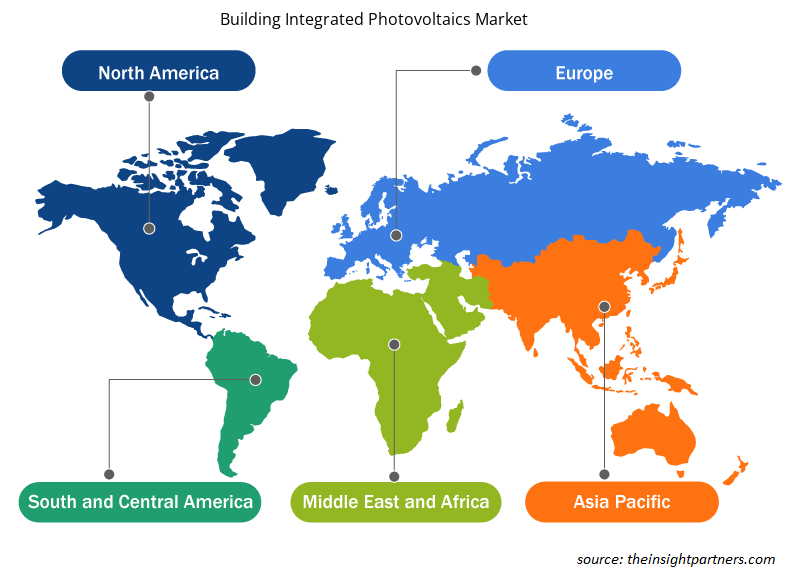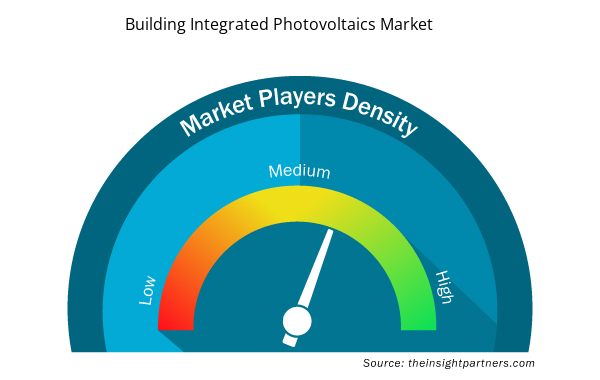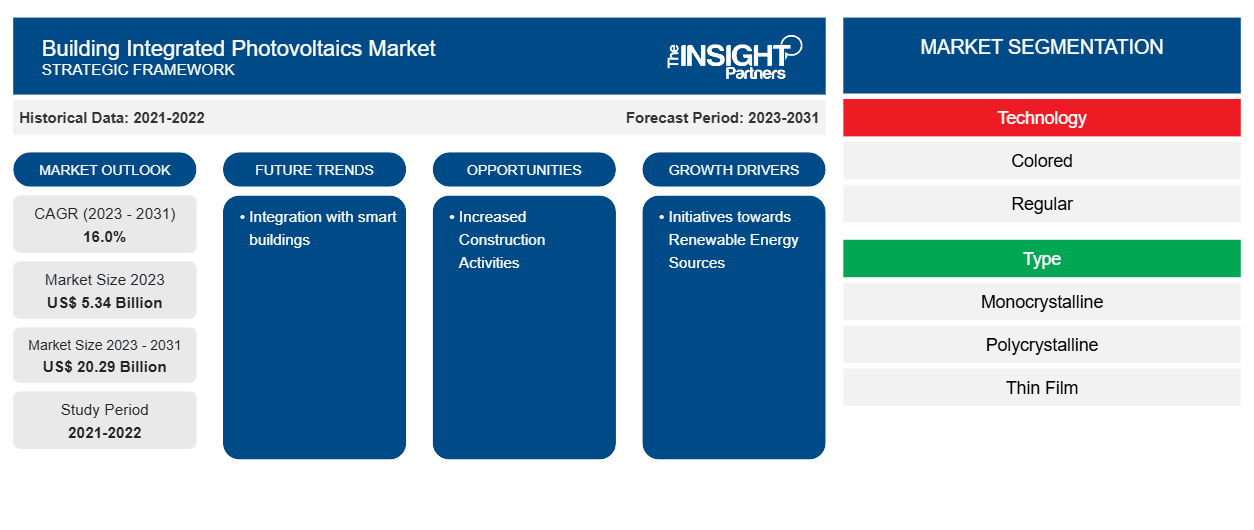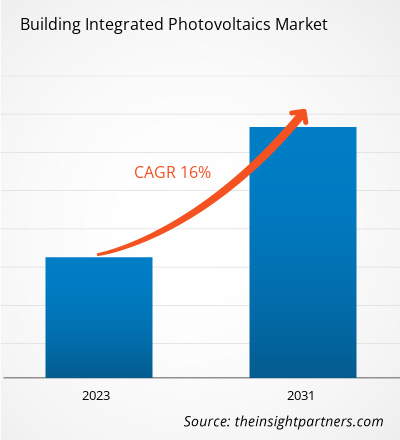Le marché du photovoltaïque intégré aux bâtiments devrait atteindre 20,29 milliards USD d'ici 2031, contre 5,34 milliards USD en 2023. Le marché devrait enregistrer un TCAC de 16,0 % au cours de la période 2023-2031. L'intégration avec les bâtiments intelligents devrait rester une tendance clé du marché.
Analyse du marché du photovoltaïque intégré aux bâtiments
La demande croissante en énergie renouvelable, combinée à l’électrification des transports et à l’implication accrue des sociétés pétrolières et gazières dans la chaîne de valeur de l’électricité, accélère la convergence des industries d’utilisation finale.
Aperçu du marché du photovoltaïque intégré aux bâtiments
Les systèmes photovoltaïques intégrés au bâtiment (BIPV) sont des produits ou systèmes de production d'énergie solaire qui s'intègrent parfaitement à l'enveloppe du bâtiment et fonctionnent comme des composants de construction tels que des façades, des toits et des fenêtres. Un système photovoltaïque intégré au bâtiment (BIPV) transforme l'énergie solaire en électricité tout en offrant une protection contre les intempéries, une isolation thermique, une réduction du bruit, un éclairage naturel et une sécurité. Les systèmes BIPV peuvent être installés pendant la phase de construction d'un bâtiment ou déployés dans le cadre de la rénovation d'un bâtiment existant lorsqu'un des composants extérieurs doit être remplacé. L'environnement construit offre une variété d'options d'intégration BIPV.
Personnalisez ce rapport en fonction de vos besoins
Vous bénéficierez d'une personnalisation gratuite de n'importe quel rapport, y compris de certaines parties de ce rapport, d'une analyse au niveau des pays, d'un pack de données Excel, ainsi que d'offres et de remises exceptionnelles pour les start-ups et les universités.
- Obtenez les principales tendances clés du marché de ce rapport.Cet échantillon GRATUIT comprendra une analyse de données, allant des tendances du marché aux estimations et prévisions.
Facteurs moteurs et opportunités du marché du photovoltaïque intégré au bâtiment
Initiatives en faveur des sources d'énergie renouvelables pour favoriser le marché
Le marché mondial du photovoltaïque intégré au bâtiment est stimulé par les efforts visant à promouvoir les énergies renouvelables. Par exemple, l’administration Biden a l’intention d’éliminer progressivement les combustibles fossiles comme source de production d’énergie aux États-Unis d’ici 2035. La Maison Blanche a annoncé un objectif de production d’énergie renouvelable de 80 % d’ici 2030 et d’une énergie sans carbone de 100 % cinq ans plus tard. Le photovoltaïque intégré au bâtiment crée de l’électricité solaire en remplaçant les éléments de construction traditionnels, notamment les toits, les puits de lumière et les façades. L’accent croissant mis sur les énergies renouvelables et la durabilité contribue à l’expansion de l’industrie du BIPV.
Augmentation des activités de construction
L’augmentation de l’activité de construction, en particulier dans les pays émergents, propulse le secteur du photovoltaïque intégré au bâtiment (BIPV). L’urbanisation rapide et la construction de nouveaux bâtiments offrent des perspectives pour la mise en œuvre de systèmes BIPV. Le besoin croissant de nouveaux bâtiments stimule l’expansion du secteur du BIPV. L’American Institute of Architects estime que les investissements dans le secteur de la construction en 2024 augmenteront de 6 % au total, avec une augmentation de 3 % pour les structures commerciales, de 15 % pour les structures industrielles et de 4 % pour les structures institutionnelles.
Analyse de segmentation du rapport sur le marché du photovoltaïque intégré au bâtiment
Les segments clés qui ont contribué à l’élaboration de l’analyse du marché du photovoltaïque intégré au bâtiment sont la technologie, le type, l’application et l’utilisation finale.
- En fonction de la technologie, le marché est segmenté en couleurs et en réguliers. Le segment coloré détenait une part de marché importante en 2023.
- En fonction du type, le marché est segmenté en monocristallin, polycristallin et film mince. Le segment monocristallin détenait une part de marché plus importante en 2023.
- En fonction des applications, le marché est segmenté en toitures, murs, verre, façades et autres. Le segment des toitures détenait une part de marché plus importante en 2023.
- En fonction de l'utilisation finale, le marché est segmenté en secteurs industriel, commercial et résidentiel. Le segment résidentiel détenait la plus grande part du marché en 2023.
Analyse des parts de marché du photovoltaïque intégré aux bâtiments par zone géographique
La portée géographique du rapport sur le marché du photovoltaïque intégré au bâtiment est principalement divisée en cinq régions : Amérique du Nord, Asie-Pacifique, Europe, Moyen-Orient et Afrique, et Amérique du Sud et centrale.
La croissance du secteur de la construction dans les pays d'Amérique du Nord, associée à une augmentation des espaces commerciaux, est le facteur clé de la croissance du marché du photovoltaïque intégré aux bâtiments dans la région. L'intégration d' équipements de production d'énergie solaire directement dans les zones de construction pourrait améliorer l'efficacité des matériaux et réduire les coûts des produits. En outre, la prise de conscience croissante de la nécessité d'améliorer l'efficacité énergétique des bâtiments a favorisé l'utilisation de technologies énergétiques propres ou renouvelables. L'Amérique du Nord affiche une augmentation des initiatives et des plans d'action pour améliorer l'efficacité énergétique. Par exemple, le gouvernement du Canada s'est engagé à rendre les maisons et les bâtiments plus économes en énergie avec l'aide de son fonds pour une économie à faibles émissions de carbone et d'autres initiatives d'infrastructure. En mai 2021, le gouvernement a lancé l'initiative Canada Greener Homes pour moderniser les maisons, les bâtiments et les complexes commerciaux afin d'améliorer leur efficacité énergétique. Selon les recherches menées par l'American Council for an Energy-Efficient Economy, une augmentation de l'efficacité énergétique peut réduire de moitié la consommation d'énergie et les émissions de GES aux États-Unis d'ici 2050. Ainsi, ces facteurs contribuent à la croissance du marché.
Aperçu régional du marché du photovoltaïque intégré aux bâtiments
Les tendances et facteurs régionaux influençant le marché du photovoltaïque intégré au bâtiment tout au long de la période de prévision ont été expliqués en détail par les analystes d’Insight Partners. Cette section traite également des segments et de la géographie du marché du photovoltaïque intégré au bâtiment en Amérique du Nord, en Europe, en Asie-Pacifique, au Moyen-Orient et en Afrique, ainsi qu’en Amérique du Sud et en Amérique centrale.

- Obtenez les données régionales spécifiques au marché du photovoltaïque intégré au bâtiment
Portée du rapport sur le marché du photovoltaïque intégré aux bâtiments
| Attribut de rapport | Détails |
|---|---|
| Taille du marché en 2023 | 5,34 milliards de dollars américains |
| Taille du marché d'ici 2031 | 20,29 milliards de dollars américains |
| Taux de croissance annuel composé mondial (2023-2031) | 16,0% |
| Données historiques | 2021-2022 |
| Période de prévision | 2023-2031 |
| Segments couverts | Par technologie
|
| Régions et pays couverts | Amérique du Nord
|
| Leaders du marché et profils d'entreprises clés |
|
Densité des acteurs du marché : comprendre son impact sur la dynamique des entreprises
Le marché du photovoltaïque intégré au bâtiment connaît une croissance rapide, tirée par la demande croissante des utilisateurs finaux en raison de facteurs tels que l'évolution des préférences des consommateurs, les avancées technologiques et une plus grande sensibilisation aux avantages du produit. À mesure que la demande augmente, les entreprises élargissent leurs offres, innovent pour répondre aux besoins des consommateurs et capitalisent sur les tendances émergentes, ce qui alimente davantage la croissance du marché.
La densité des acteurs du marché fait référence à la répartition des entreprises ou des sociétés opérant sur un marché ou un secteur particulier. Elle indique le nombre de concurrents (acteurs du marché) présents sur un marché donné par rapport à sa taille ou à sa valeur marchande totale.
Les principales entreprises opérant sur le marché du photovoltaïque intégré au bâtiment sont :
- Héliatek
- AGC Inc.
- ertex solartechnik GmbH
- ISSOL sa
- MetSolar
- Groupe Onyx Solar LLC
Avis de non-responsabilité : les sociétés répertoriées ci-dessus ne sont pas classées dans un ordre particulier.

- Obtenez un aperçu des principaux acteurs du marché du photovoltaïque intégré au bâtiment
Actualités et développements récents du marché du photovoltaïque intégré au bâtiment
Le marché du photovoltaïque intégré au bâtiment est évalué en collectant des données qualitatives et quantitatives après des recherches primaires et secondaires, qui comprennent des publications d'entreprise importantes, des données d'association et des bases de données. Quelques-uns des développements du marché du photovoltaïque intégré au bâtiment sont répertoriés ci-dessous :
- Onyx Renewable Partners, LP (Onyx) et Sol Systems LLC (Sol) ont annoncé un accord pour l'achat et la vente d'un portefeuille de développement solaire et de stockage de 24 mégawatts (MWdc) qui fournira une énergie propre et fiable aux entreprises et aux communautés dans cinq États. Sol a créé et développé les huit projets solaires et de stockage de production décentralisée (DG) du portefeuille et reste engagé envers ses clients par un engagement continu et actif dans les activités de coordination des clients et des projets. (Source : Onyx Renewable Partners, LP, communiqué de presse, février 2024)
- Heliatek, leader mondial du photovoltaïque organique et Triflex, expert en étanchéité liquide, ont annoncé leur partenariat exclusif pour proposer une solution système complète pour la rénovation de toiture la plus durable et la plus efficace. En combinant les films solaires HeliaSol d'Heliatek et l'étanchéité liquide appliquée Triflex, les clients bénéficieront d'une solution testée conjointement pour sceller solidement la toiture, prolongeant ainsi sa durée de vie tout en produisant simultanément de l'énergie solaire propre. (Source : Heliatek, communiqué de presse, novembre 2023)
Rapport sur le marché du photovoltaïque intégré au bâtiment : couverture et livrables
Le rapport « Taille et prévisions du marché du photovoltaïque intégré au bâtiment (2021-2031) » fournit une analyse détaillée du marché couvrant les domaines ci-dessous :
- Taille et prévisions du marché du photovoltaïque intégré au bâtiment aux niveaux mondial, régional et national pour tous les segments de marché clés couverts par le périmètre
- Tendances du marché du photovoltaïque intégré au bâtiment ainsi que la dynamique du marché, telles que les moteurs, les contraintes et les opportunités clés
- Analyse détaillée des cinq forces de PEST/Porter et SWOT
- Analyse du marché du photovoltaïque intégré au bâtiment couvrant les principales tendances du marché, le cadre mondial et régional, les principaux acteurs, les réglementations et les développements récents du marché
- Analyse du paysage industriel et de la concurrence couvrant la concentration du marché, l'analyse de la carte thermique, les principaux acteurs et les développements récents pour le marché du photovoltaïque intégré au bâtiment
- Profils d'entreprise détaillés
- Analyse historique (2 ans), année de base, prévision (7 ans) avec TCAC
- Analyse PEST et SWO
- Taille du marché Valeur / Volume - Mondial, Régional, Pays
- Industrie et paysage concurrentiel
- Ensemble de données Excel



Report Coverage
Revenue forecast, Company Analysis, Industry landscape, Growth factors, and Trends

Segment Covered
This text is related
to segments covered.

Regional Scope
North America, Europe, Asia Pacific, Middle East & Africa, South & Central America

Country Scope
This text is related
to country scope.
Questions fréquemment posées
The market is expected to grow at a CAGR of 16.0% over the forecast period.
The estimated value of the building integrated photovoltaics market is expected to reach US$ 20.29 billion by 2031.
ClearVue Technologies Limited, AGC Inc., Onyx Solar Group LLC, Metsolar, and Heliatek are among the leading building integrated photovoltaics market.
The integration with smart buildings is likely to remain a key trends in the market.
The rising demand for renewable energy, combined with the electrification of transportation and increased involvement of oil and gas companies in the electricity value chain, is accelerating the convergence of the end-use industries.
North America dominated the building integrated photovoltaics market in 2023.
Trends and growth analysis reports related to Electronics and Semiconductor : READ MORE..
The Insight Partners performs research in 4 major stages: Data Collection & Secondary Research, Primary Research, Data Analysis and Data Triangulation & Final Review.
- Data Collection and Secondary Research:
As a market research and consulting firm operating from a decade, we have published and advised several client across the globe. First step for any study will start with an assessment of currently available data and insights from existing reports. Further, historical and current market information is collected from Investor Presentations, Annual Reports, SEC Filings, etc., and other information related to company’s performance and market positioning are gathered from Paid Databases (Factiva, Hoovers, and Reuters) and various other publications available in public domain.
Several associations trade associates, technical forums, institutes, societies and organization are accessed to gain technical as well as market related insights through their publications such as research papers, blogs and press releases related to the studies are referred to get cues about the market. Further, white papers, journals, magazines, and other news articles published in last 3 years are scrutinized and analyzed to understand the current market trends.
- Primary Research:
The primarily interview analysis comprise of data obtained from industry participants interview and answers to survey questions gathered by in-house primary team.
For primary research, interviews are conducted with industry experts/CEOs/Marketing Managers/VPs/Subject Matter Experts from both demand and supply side to get a 360-degree view of the market. The primary team conducts several interviews based on the complexity of the markets to understand the various market trends and dynamics which makes research more credible and precise.
A typical research interview fulfils the following functions:
- Provides first-hand information on the market size, market trends, growth trends, competitive landscape, and outlook
- Validates and strengthens in-house secondary research findings
- Develops the analysis team’s expertise and market understanding
Primary research involves email interactions and telephone interviews for each market, category, segment, and sub-segment across geographies. The participants who typically take part in such a process include, but are not limited to:
- Industry participants: VPs, business development managers, market intelligence managers and national sales managers
- Outside experts: Valuation experts, research analysts and key opinion leaders specializing in the electronics and semiconductor industry.
Below is the breakup of our primary respondents by company, designation, and region:

Once we receive the confirmation from primary research sources or primary respondents, we finalize the base year market estimation and forecast the data as per the macroeconomic and microeconomic factors assessed during data collection.
- Data Analysis:
Once data is validated through both secondary as well as primary respondents, we finalize the market estimations by hypothesis formulation and factor analysis at regional and country level.
- Macro-Economic Factor Analysis:
We analyse macroeconomic indicators such the gross domestic product (GDP), increase in the demand for goods and services across industries, technological advancement, regional economic growth, governmental policies, the influence of COVID-19, PEST analysis, and other aspects. This analysis aids in setting benchmarks for various nations/regions and approximating market splits. Additionally, the general trend of the aforementioned components aid in determining the market's development possibilities.
- Country Level Data:
Various factors that are especially aligned to the country are taken into account to determine the market size for a certain area and country, including the presence of vendors, such as headquarters and offices, the country's GDP, demand patterns, and industry growth. To comprehend the market dynamics for the nation, a number of growth variables, inhibitors, application areas, and current market trends are researched. The aforementioned elements aid in determining the country's overall market's growth potential.
- Company Profile:
The “Table of Contents” is formulated by listing and analyzing more than 25 - 30 companies operating in the market ecosystem across geographies. However, we profile only 10 companies as a standard practice in our syndicate reports. These 10 companies comprise leading, emerging, and regional players. Nonetheless, our analysis is not restricted to the 10 listed companies, we also analyze other companies present in the market to develop a holistic view and understand the prevailing trends. The “Company Profiles” section in the report covers key facts, business description, products & services, financial information, SWOT analysis, and key developments. The financial information presented is extracted from the annual reports and official documents of the publicly listed companies. Upon collecting the information for the sections of respective companies, we verify them via various primary sources and then compile the data in respective company profiles. The company level information helps us in deriving the base number as well as in forecasting the market size.
- Developing Base Number:
Aggregation of sales statistics (2020-2022) and macro-economic factor, and other secondary and primary research insights are utilized to arrive at base number and related market shares for 2022. The data gaps are identified in this step and relevant market data is analyzed, collected from paid primary interviews or databases. On finalizing the base year market size, forecasts are developed on the basis of macro-economic, industry and market growth factors and company level analysis.
- Data Triangulation and Final Review:
The market findings and base year market size calculations are validated from supply as well as demand side. Demand side validations are based on macro-economic factor analysis and benchmarks for respective regions and countries. In case of supply side validations, revenues of major companies are estimated (in case not available) based on industry benchmark, approximate number of employees, product portfolio, and primary interviews revenues are gathered. Further revenue from target product/service segment is assessed to avoid overshooting of market statistics. In case of heavy deviations between supply and demand side values, all thes steps are repeated to achieve synchronization.
We follow an iterative model, wherein we share our research findings with Subject Matter Experts (SME’s) and Key Opinion Leaders (KOLs) until consensus view of the market is not formulated – this model negates any drastic deviation in the opinions of experts. Only validated and universally acceptable research findings are quoted in our reports.
We have important check points that we use to validate our research findings – which we call – data triangulation, where we validate the information, we generate from secondary sources with primary interviews and then we re-validate with our internal data bases and Subject matter experts. This comprehensive model enables us to deliver high quality, reliable data in shortest possible time.


 Obtenez un échantillon gratuit pour ce rapport
Obtenez un échantillon gratuit pour ce rapport